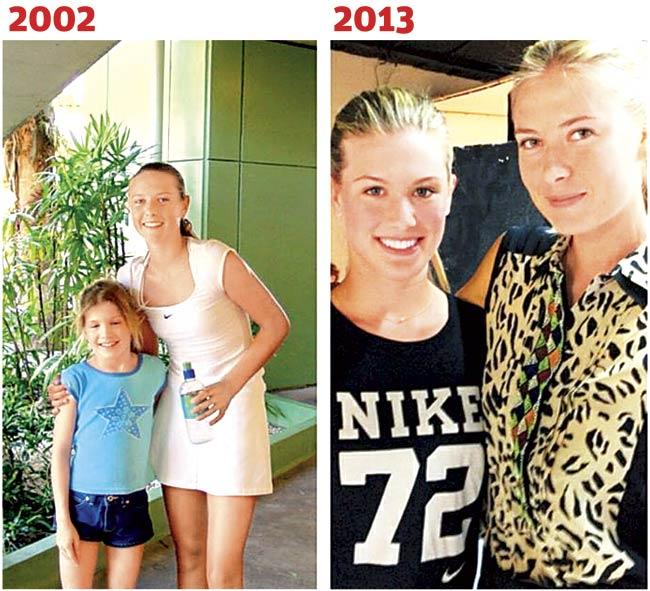Canadian tennis player Eugenie Bouchard’s revelation of preserving her photograph as an eight-year-old posing with Maria Sharapova (then 15), who she faces in the French Open semi-finals in Paris today, adds to the many fascinating off-field stories in sport

 Canadian tennis player Eugenie Bouchard’s revelation of preserving her photograph as an eight-year-old posing with Maria Sharapova (then 15), who she faces in the French Open semi-finals in Paris today, adds to the many fascinating off-field stories in sport.
Canadian tennis player Eugenie Bouchard’s revelation of preserving her photograph as an eight-year-old posing with Maria Sharapova (then 15), who she faces in the French Open semi-finals in Paris today, adds to the many fascinating off-field stories in sport.
Bouchard admitted that she looked up to the Russian and was inspired by her. Her semi-final entry is no mean feat and she’ll have to ward off every bit of emotion and nostalgia attached to this vital clash. The photograph story caused me to recall some stories of preservation and inspiration.
ADVERTISEMENT

Canadian tennis player Eugenie Bouchard with Maria Sharapova in 2002 and 2013. Bouchard will face Sharapova in the French Open semi-finals in Paris today. Pic/Facebook
The ones that came to mind concerned former Mumbai cricket captain Milind Rege, who in his younger days, used to carry an action photograph of departed India batsman Dilip Sardesai in his wallet.Rege said he started keeping the photograph in his wallet ever since he saw Sardesai batting for the Associated Cement Companies in 1963. And it stayed there for a while, even after Rege made his first-class debut for Mumbai in the 1968-69 season.
Rege showed that photograph to Sardesai while he shared a room with him at Solapur during the Ranji Trophy game against Maharashtra in November 1968. The typical Sardesai response went like this: “Okay, enough of the fuss. Now, play alongside me.”
Five years later, far away in Barbados, a young cricket enthusiast watched the West Indies draw the second Test of the 1972-73 series against the touring Australians at the Kensington Oval. As the Australians boarded their bus after the game, the bowler thrust a dollar note at Greg Chappell and asked the star batsman to sign it.
“Do you play cricket,” asked Chappell, and the boy said: “Yeah man. I’ll play with you some day.” He turned out to be Joel Garner and in four years’ time, he was bowling to Chappell in Kerry Packer’s World Series Cricket. The story doesn’t end there.
I met Garner at the Cricket Club of India when he came as manager of the West Indies ‘A’ side in 1998 and asked him about the above incident which was related in Adrian McGregor’s biography of Chappell. Garner shocked me by revealing that he still had the dollar note and carried it with him everywhere.
The next afternoon, Garner posed for this newspaper holding the dollar note that also had signatures of Chappell’s teammates, Dennis Lillee and Keith Stackpole. “This note means a lot to me. I take it wherever I go as a remembrance of my early years in the game. I will present it to my 16-year-old daughter Jewel when she grows up and is aware of how valuable this is,” Garner said then.
More recently, Sachin Tendulkar revealed that he treasured the coins he earned from his coach Ramakant Achrekar, who used to place a one-rupee coin on the stumps. A bowler who dismissed a tired Tendulkar in the final session of nets at Shivaji Park could keep the coin. His talent and determination ensured he earned far more than just a couple.
While Tendulkar’s prized possessions were coins, Ian Chappell’s constant in his wallet was a note which he wrote to himself as a 16-year-old cricketer in 1959 when he and his South Australia schoolboys teammates were taken around the Adelaide Oval by then South Australia coach Geff Noblet.
The boys were also taken to the South Australia dressing room where Noblet asked the boys to write down their cricketing ambitions on a piece of paper and place it in their wallets, “as a constant reminder of what you wish to achieve in this game” (Chappell’s words in his biography Hitting Out written by teammate Ashley Mallett).
The note stayed there at least till February 4, 1971 when Chappell became captain of Australia. That afternoon, state player turned journalist Allan Shiell phoned Chappell to break the news of his captaincy. After the news settled in, Chappell pulled out his wallet and stared at the words in the crumpled piece of paper: “My ambition is to captain Australia.”
Not that he ever craved to displace Bill Lawry as captain, but Chappell scribbled those lines because he believed in aiming for the highest honour in Australian cricket and that was to captain his country.
He said he tossed the paper away when he became captain because “it had done its job,” just like he did to the captaincy despite winning the 1975 Ashes in England. Of course, there’s no way tennis star Bouchard will chuck away that 2002 photograph with Sharapova.
Clayton Murzello is mid-day’s Group Sports Editor
 Subscribe today by clicking the link and stay updated with the latest news!" Click here!
Subscribe today by clicking the link and stay updated with the latest news!" Click here!







